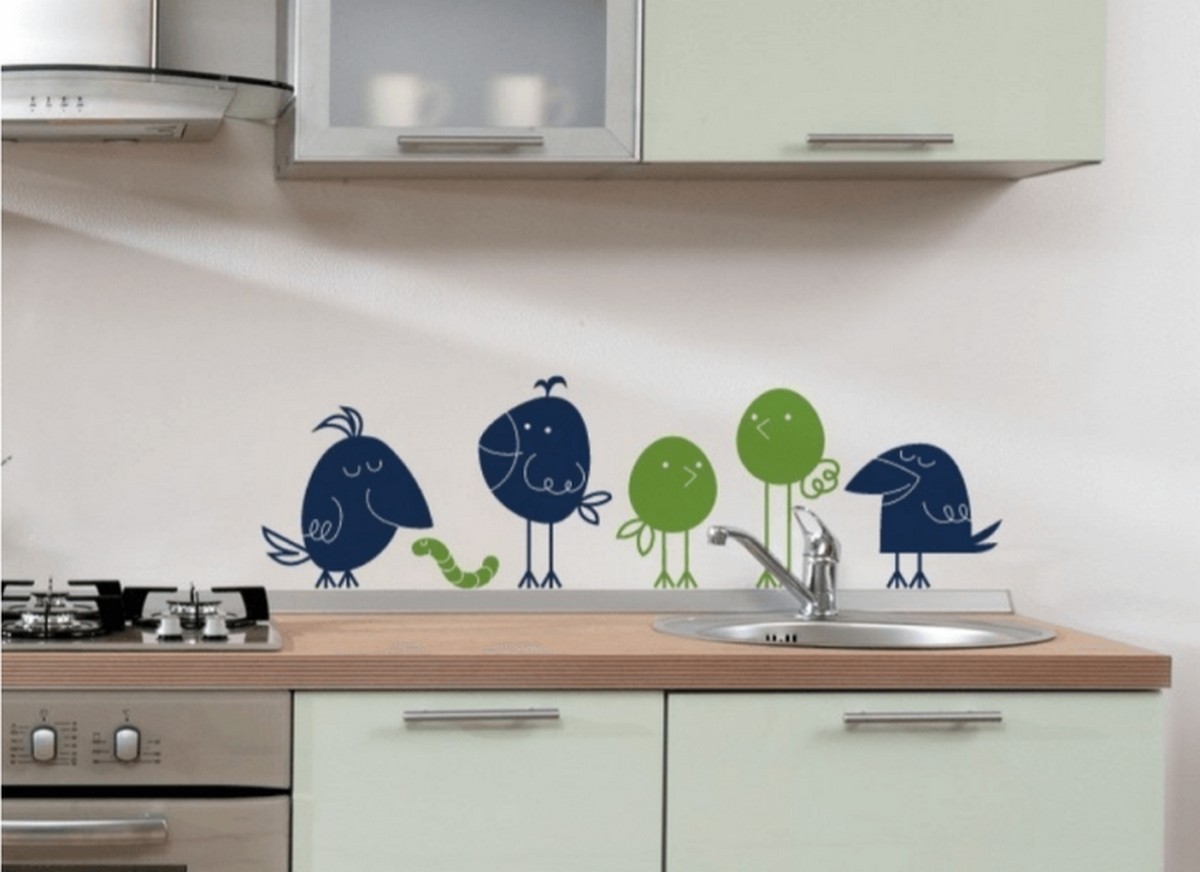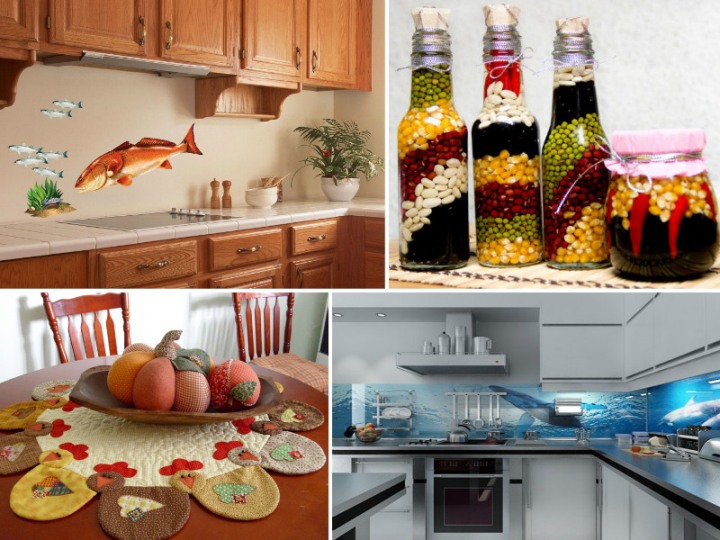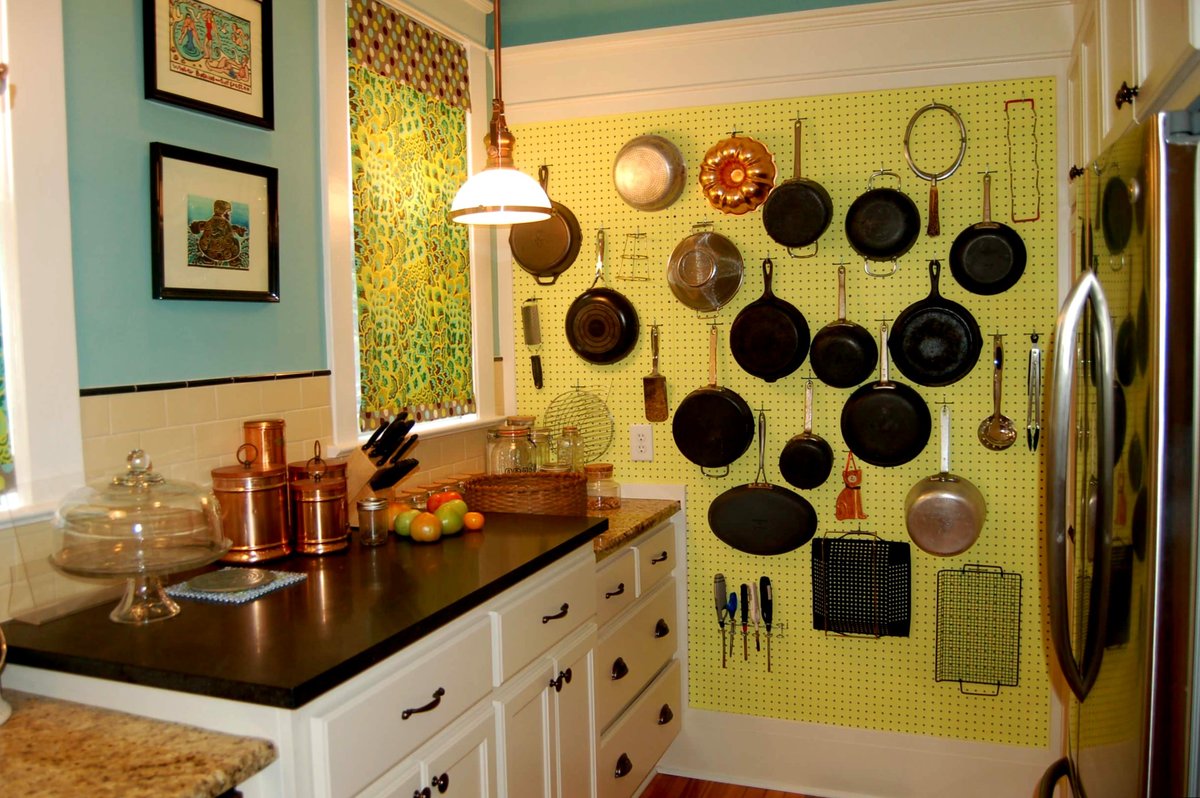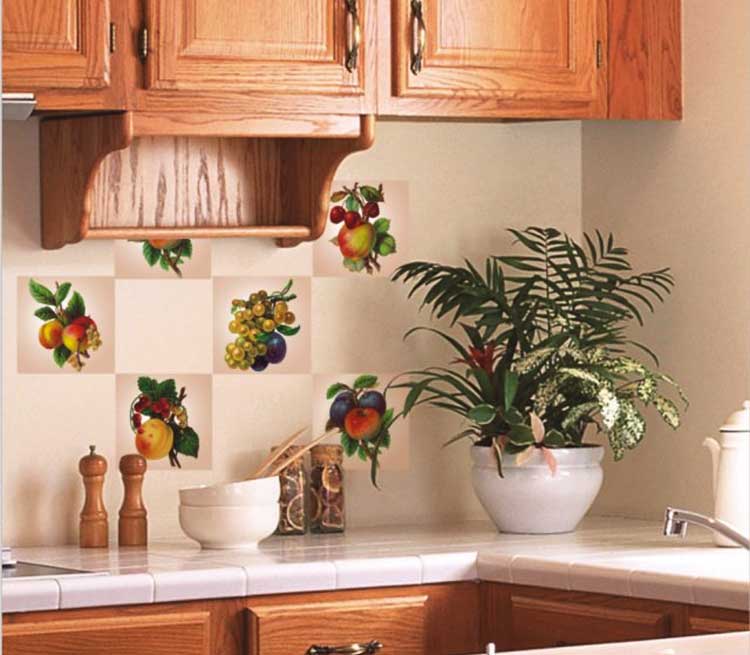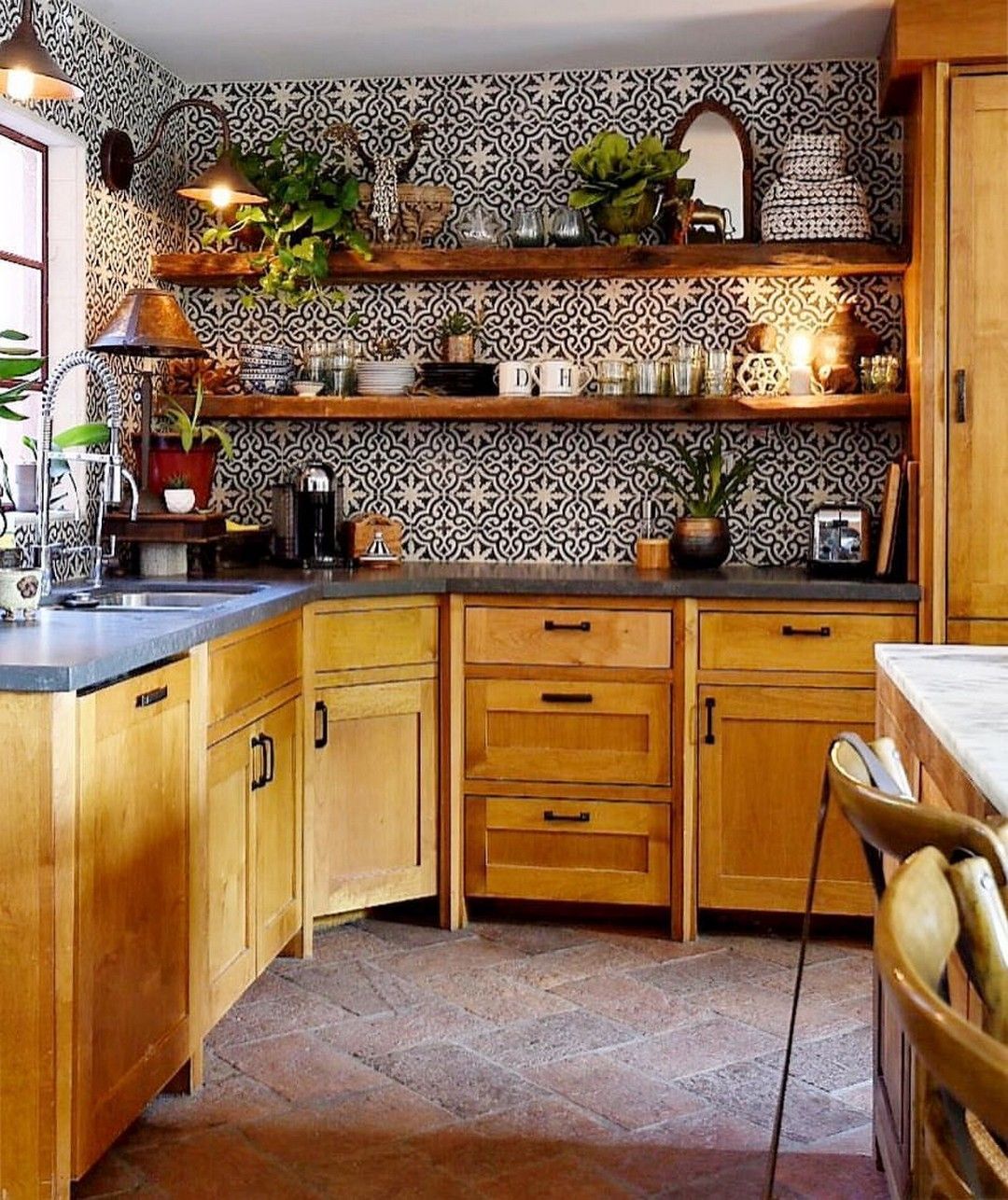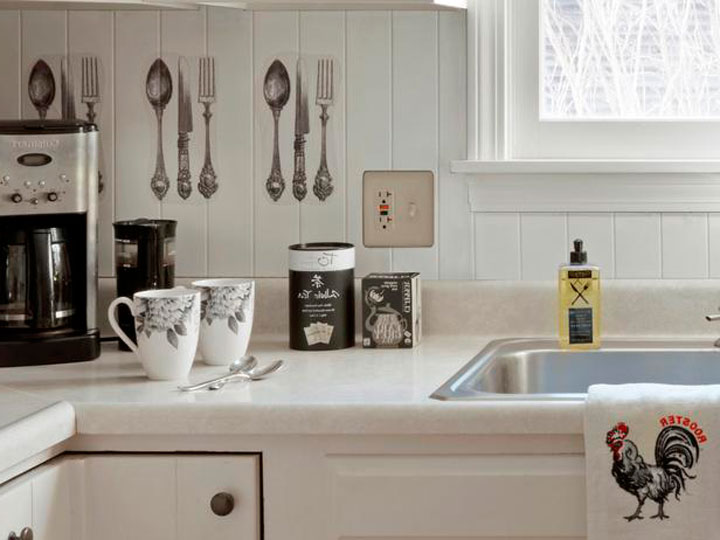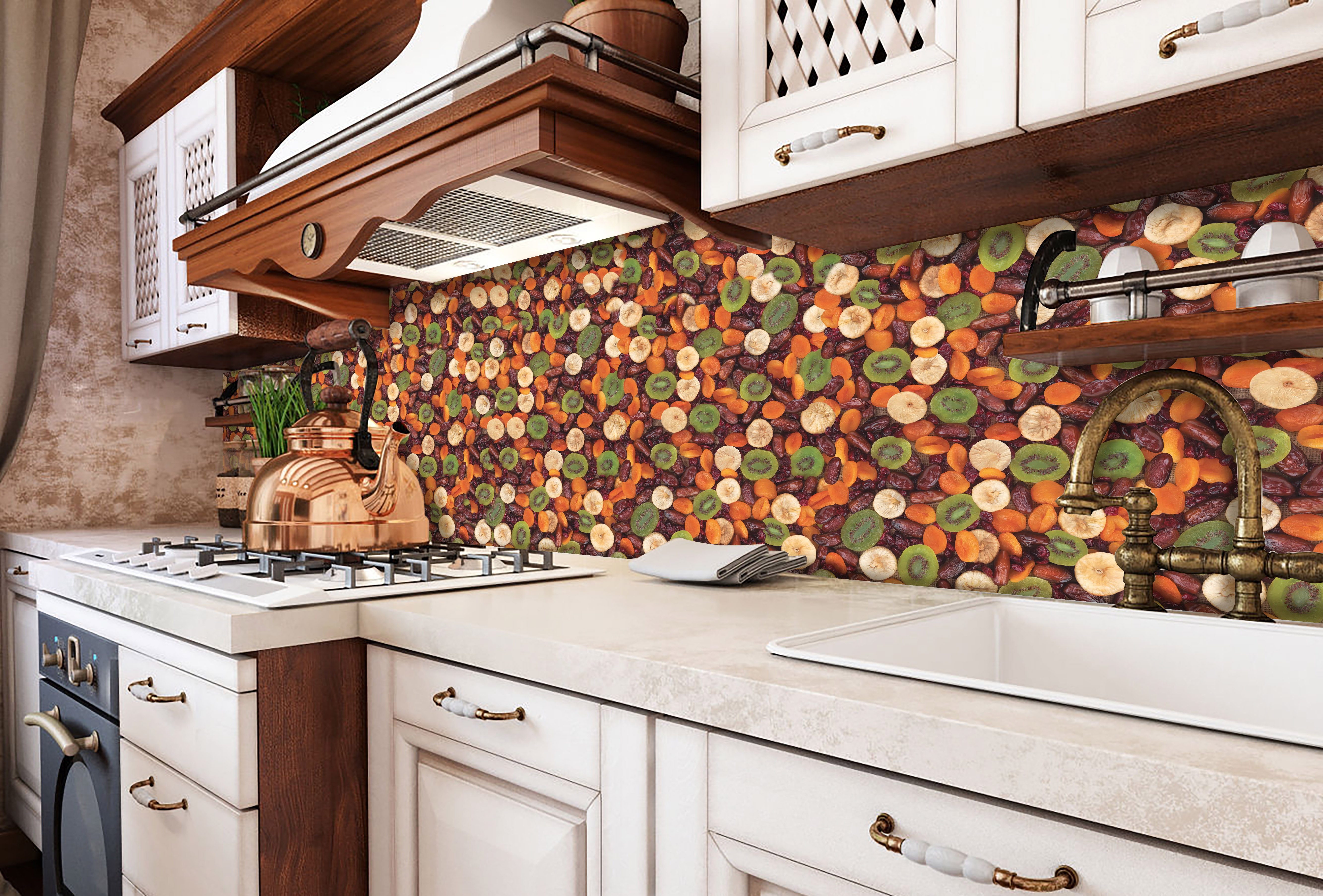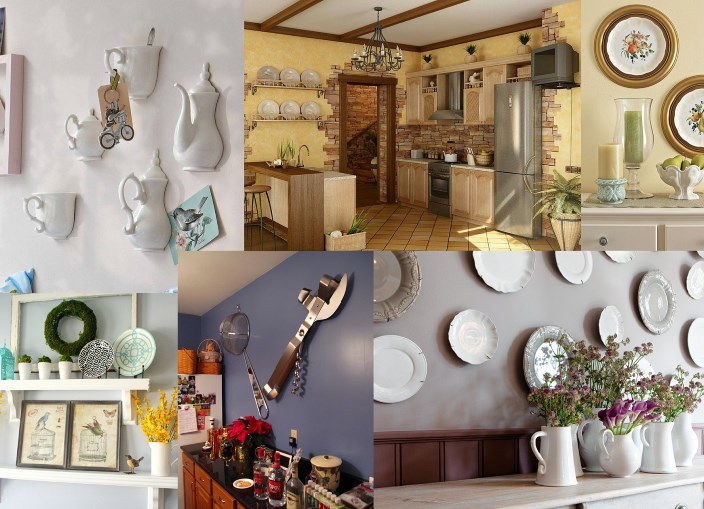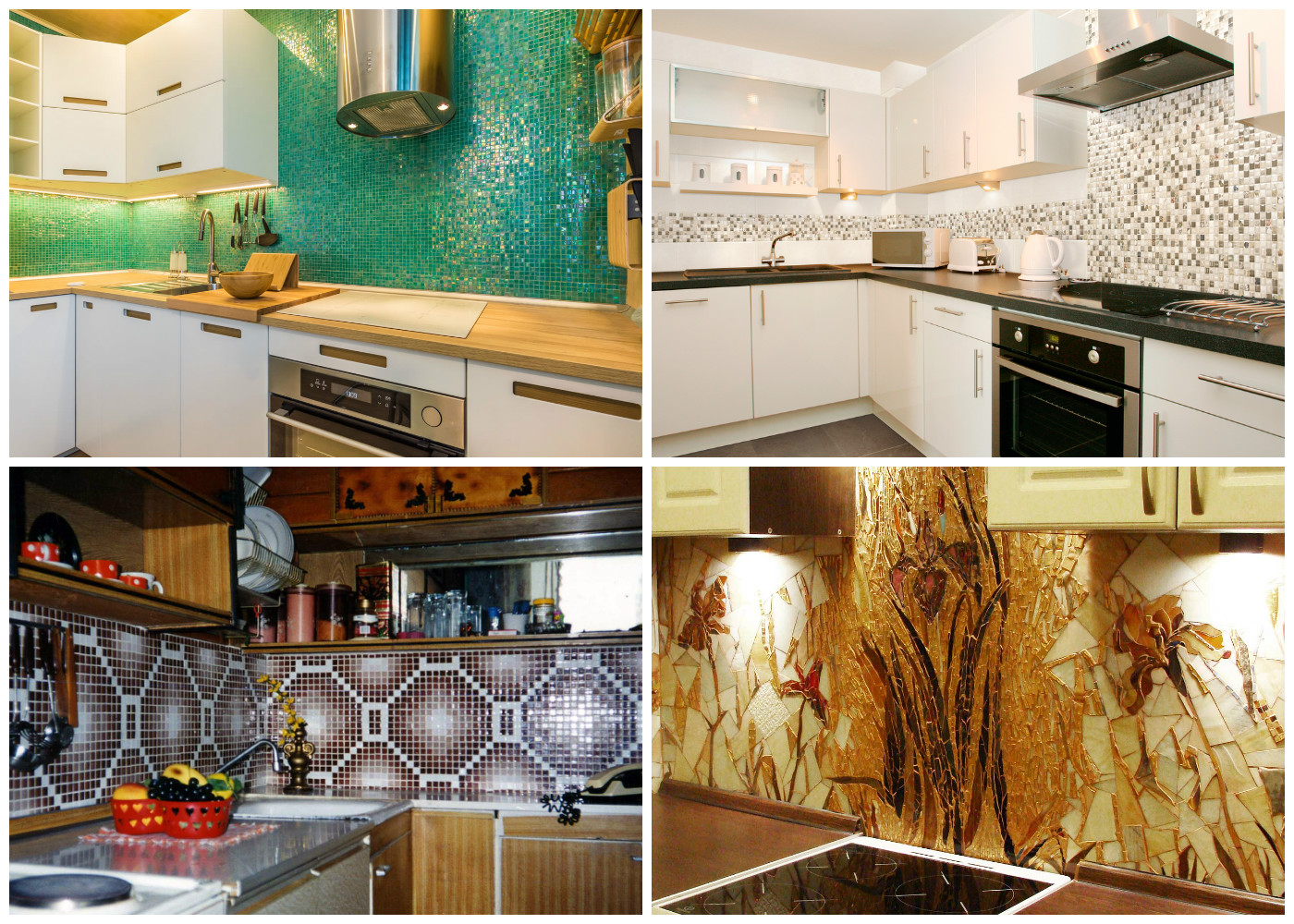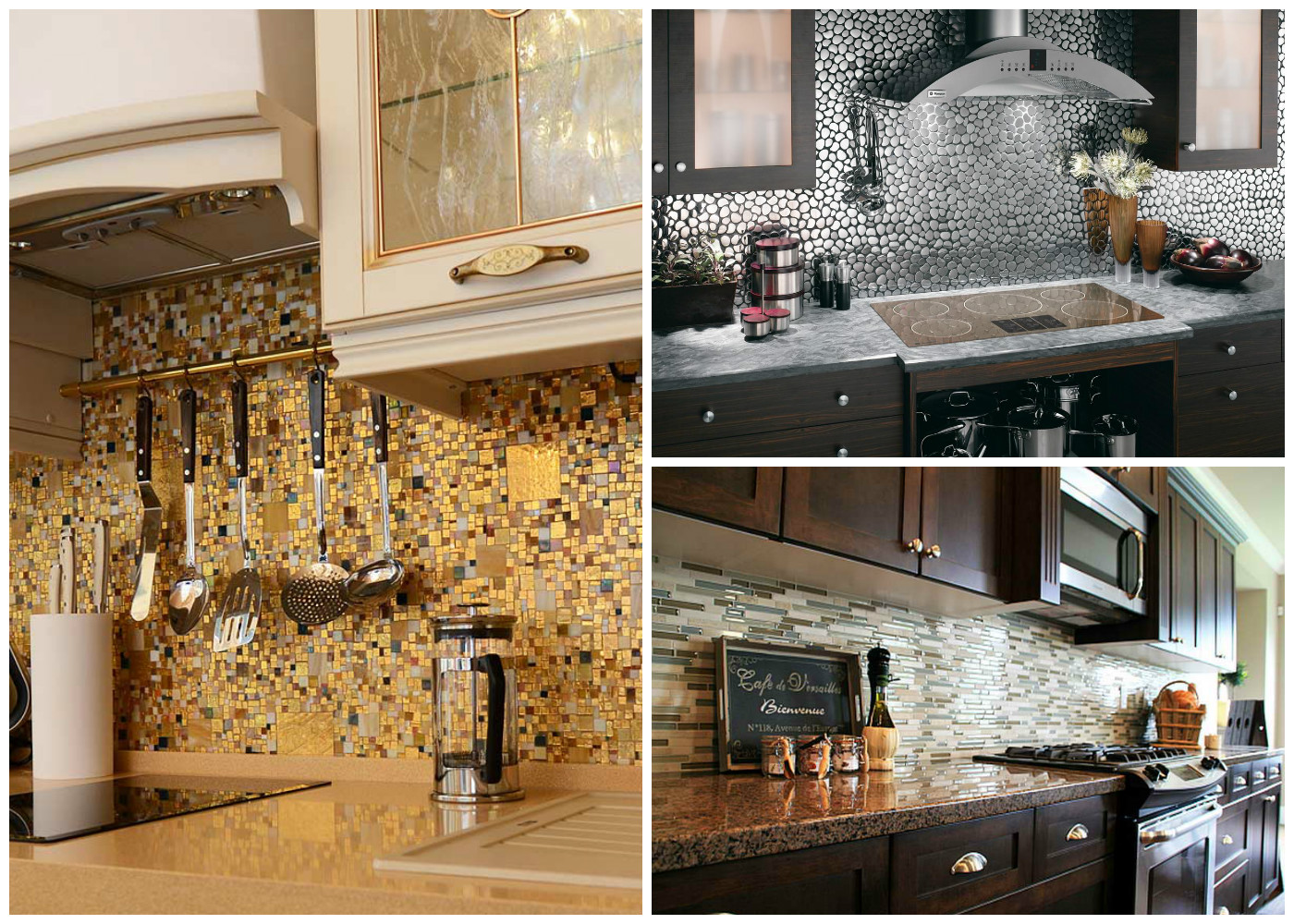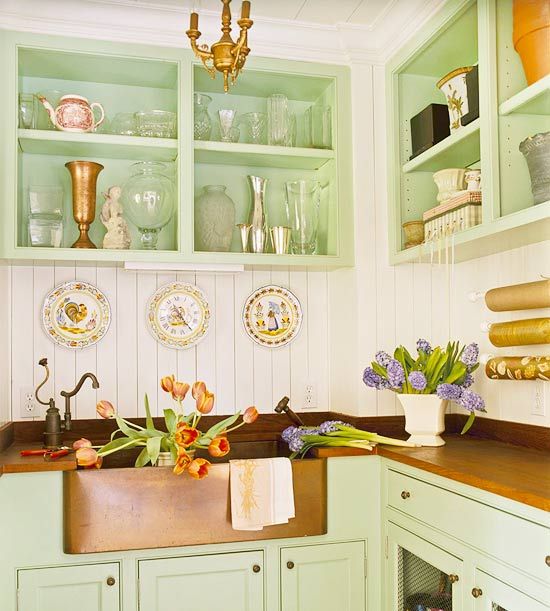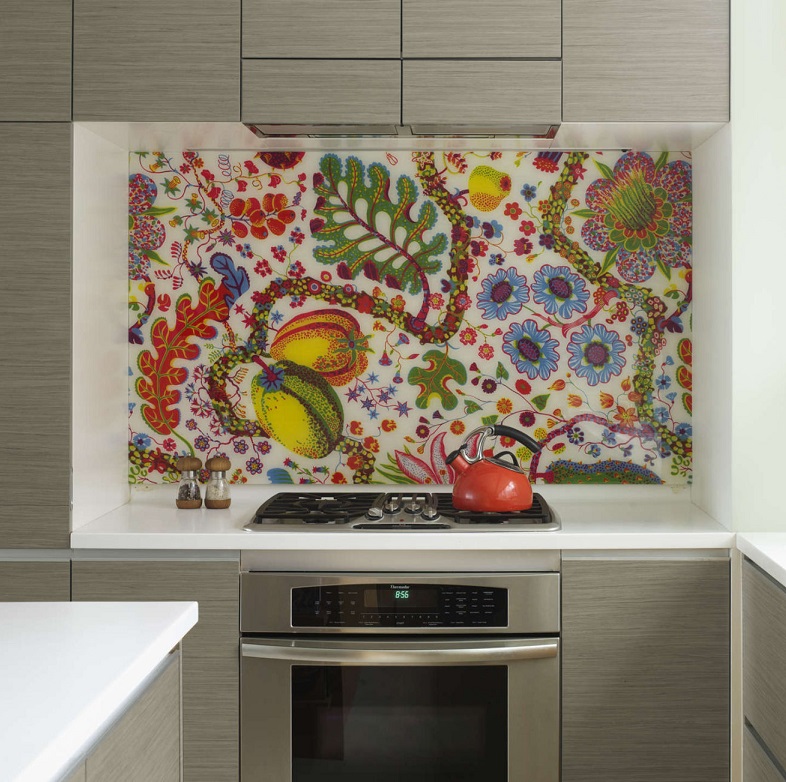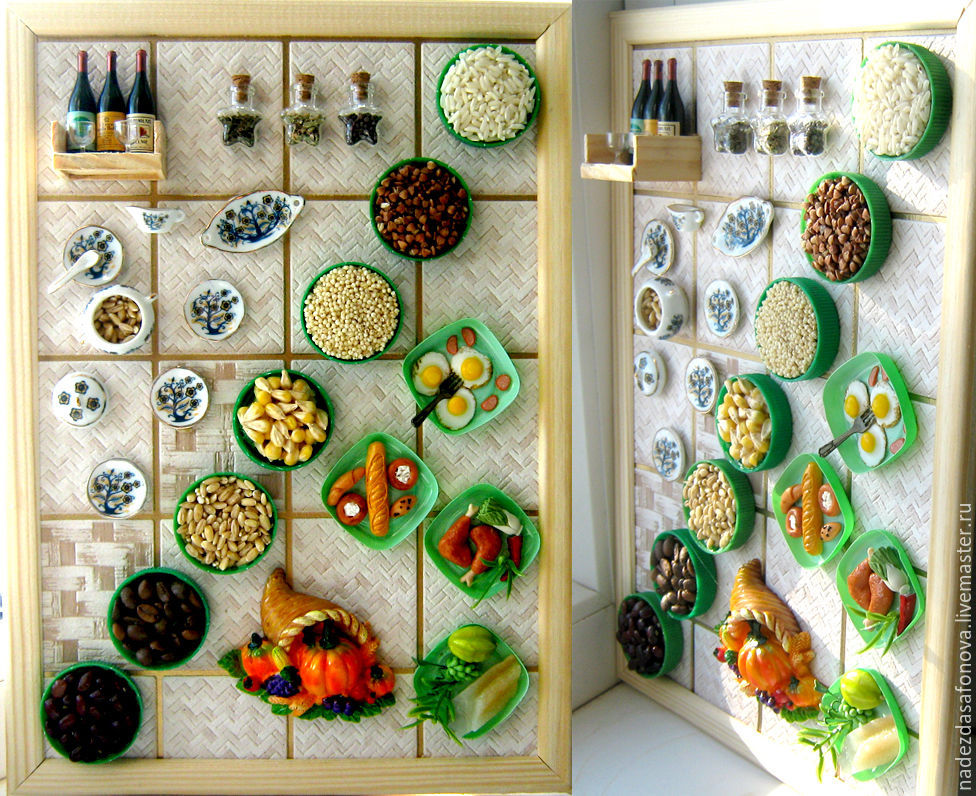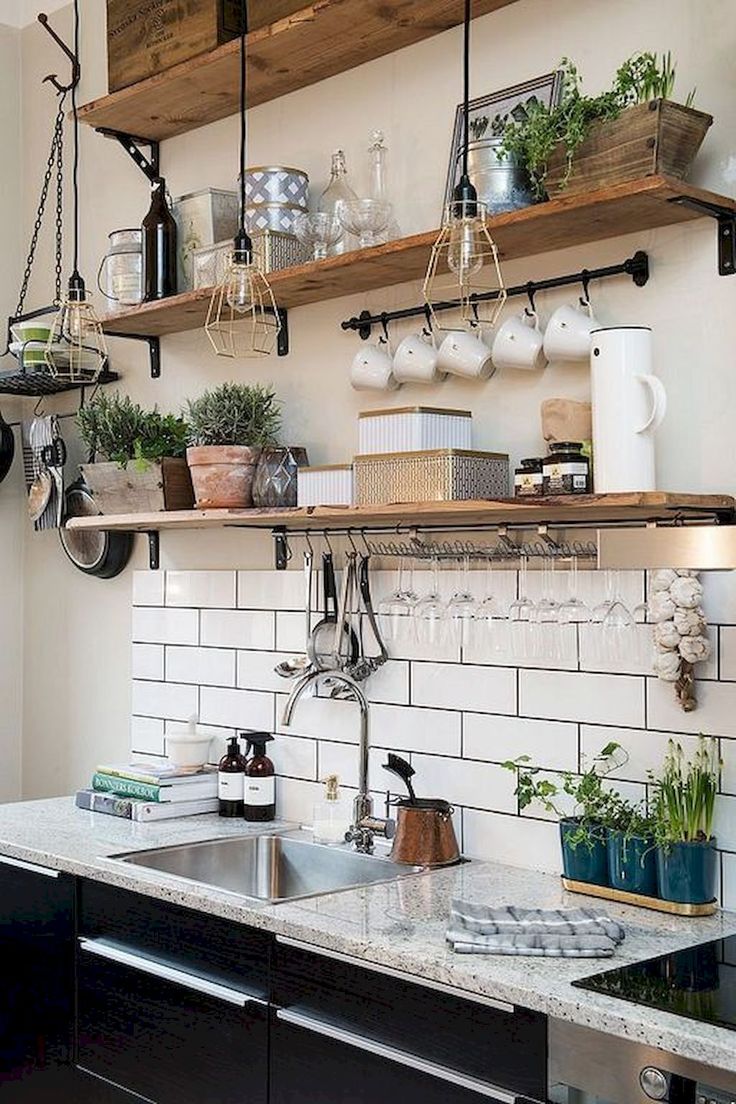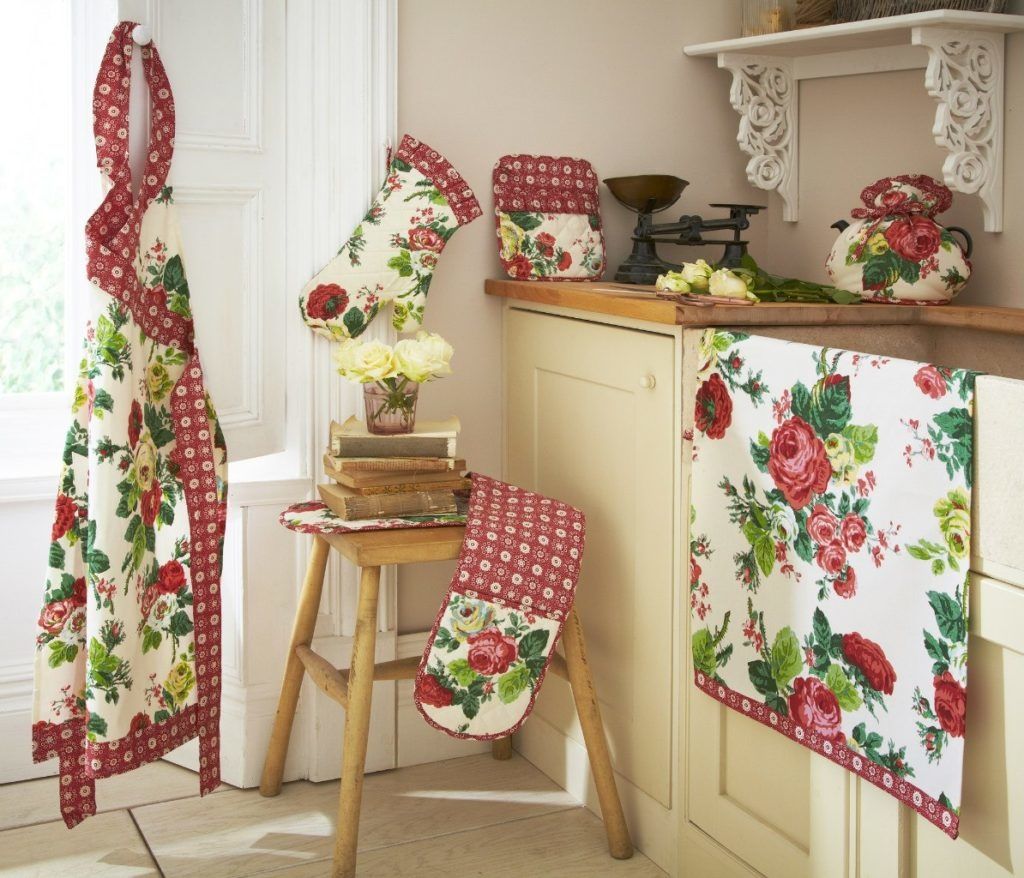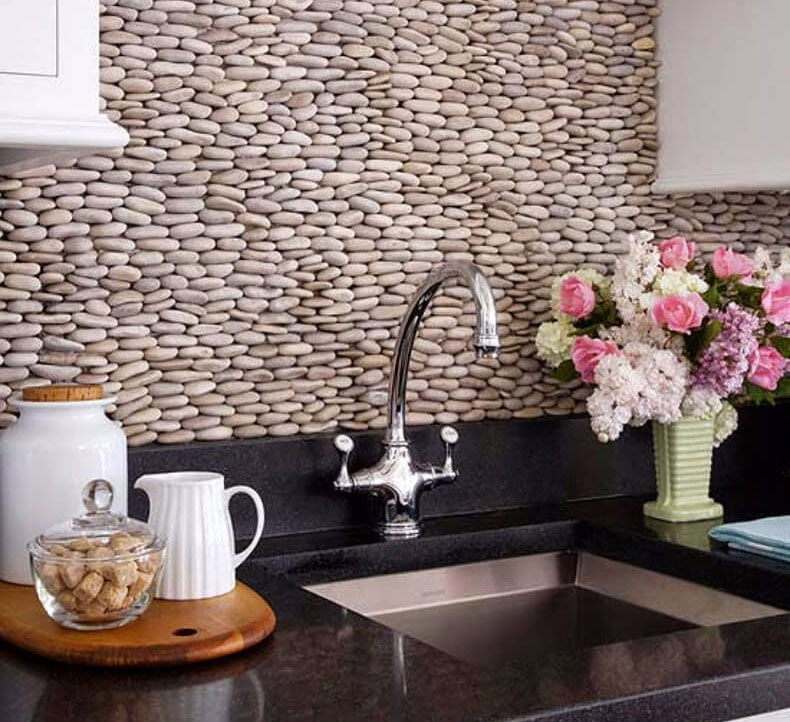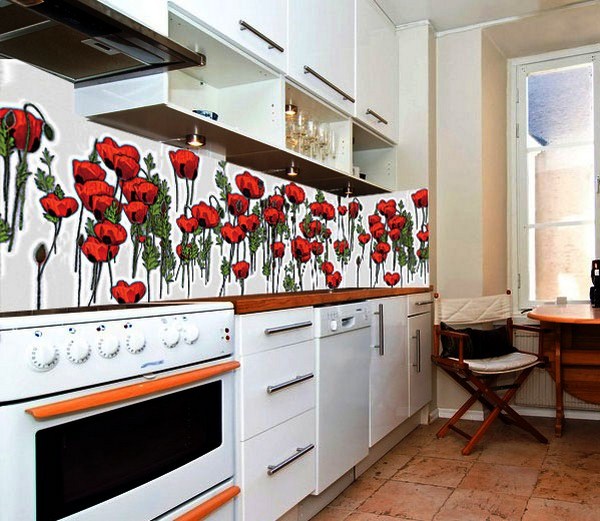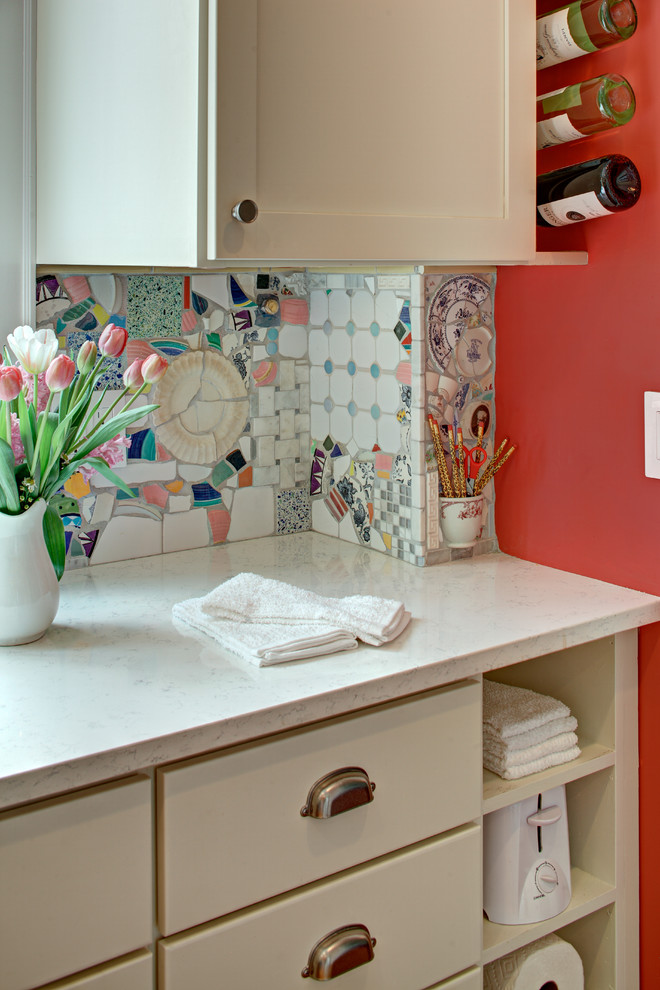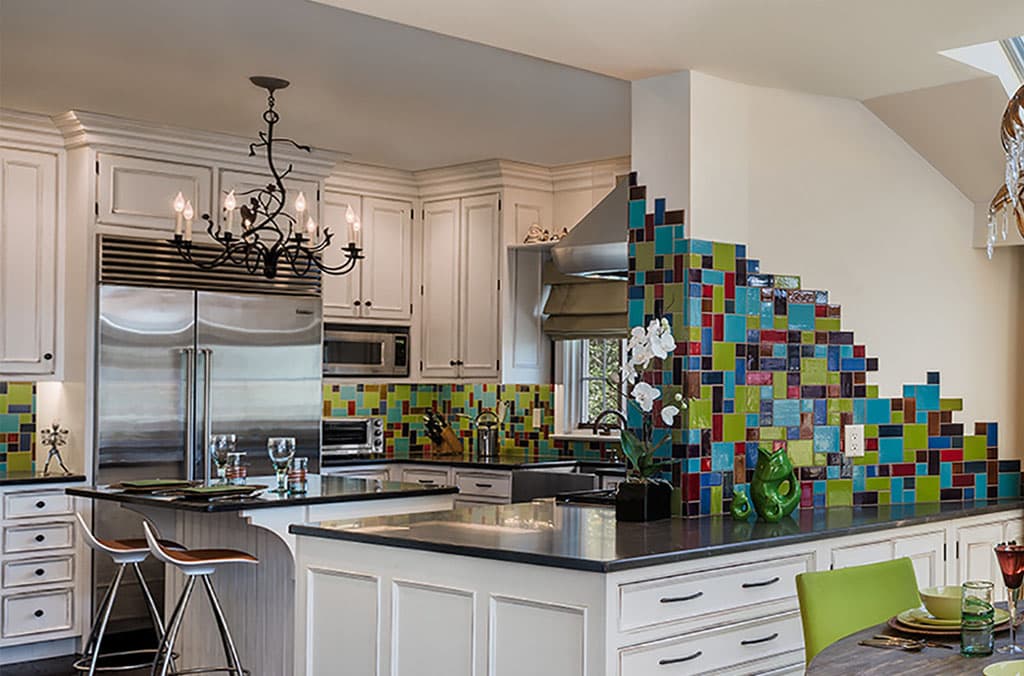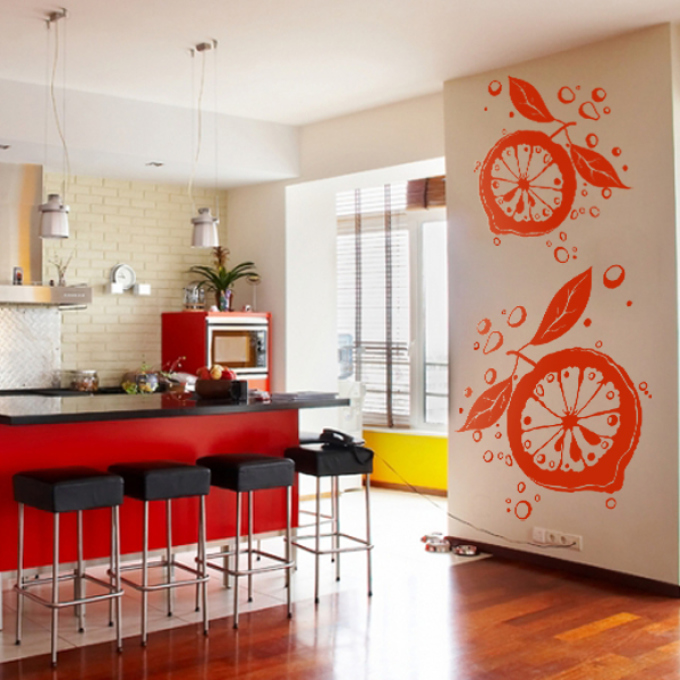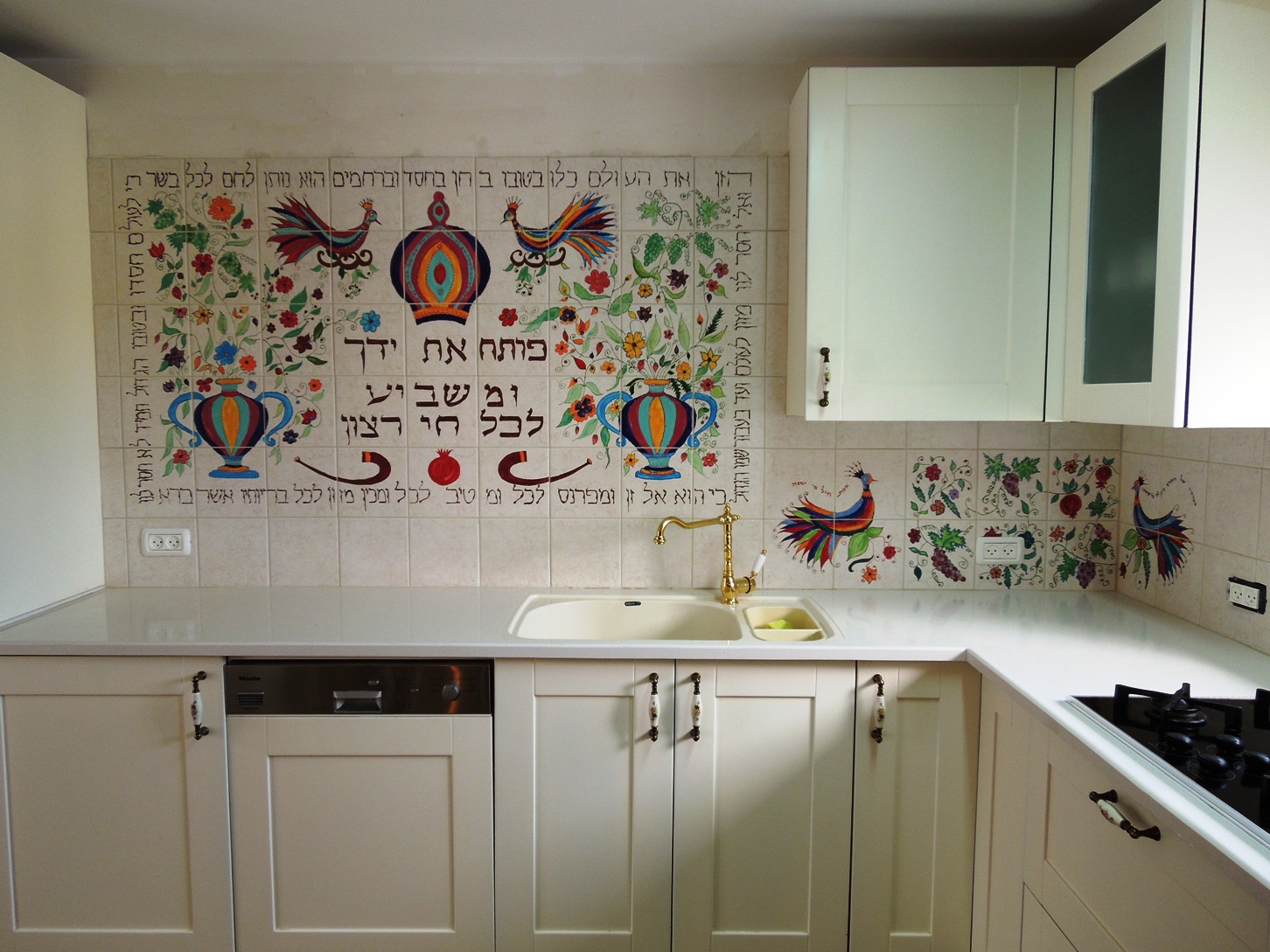Little things and accessories
Little things and accessories are of great importance in the design of the kitchen. They don't have to be useful.
It is enough that they attract attention and delight with their appearance., These are:
- salt dough crafts;
- refrigerator magnets;
- vases;
- holders for small items;
- pots;
- dummies of vegetables and fruits;
- garlands of onions or garlic;
- cans with bulk products;
- towels;
- holders and hangers;
- dividers for drawers.
Sometimes special decorative elements with colored filling are made for the kitchen. You can take several identical glass bottles and pour sugar or salt tinted with different colors into them. (You can add color to the products with gouache or food colors; they also suggest using grated crayons for decoration). You need to fill the container with filling in layers of approximately the same thickness. The filled vessels remain up to the top on an open shelf. The decoration is ready.
Ordinary vegetables and fruits placed in a beautifully shaped transparent vessel can act as a kitchen decoration. To create a composition, you can take:
- ranetki;
- pea pods;
- pepper (hot);
- berries.
The fruit should be beautiful, with no signs of rot or other damage. The container is steamed or heated in an oven for 5 minutes. The workpieces are beautifully stacked and poured with strong saline, alcohol or formalin. The lid of a bottle or can for fidelity can be sealed with wax.
DIY kitchen crafts create from the most unexpected things. Jars and cups are used for original lamps. Coasters are made of corks for hot dishes. You can use knitwear as a practical little thing.
Craftswomen are able to give hot coasters an original look. Those who know how to handle crochet and thread can easily knit a stand in the form of half an apple or pear, and so on.
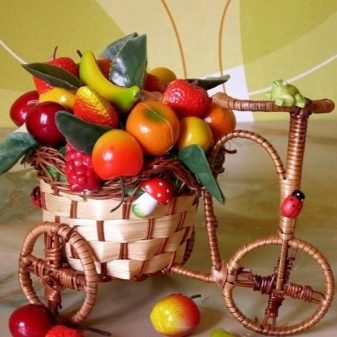

A necessary thing in the kitchen is a container for bags. It is most convenient to use a bag, but so that it is not boring and ugly, you can arrange it in the form of a hanging doll. To do this, you need to use pieces of fabric. Make a doll a face, a skirt, arms and legs, an eyelet for which you can hang the craft. A funny practical little thing will take its place in the kitchen interior.
You can use elements of kitchen utensils to create coziness. For example, a metal float is quite capable of acting as a shade. A lighting fixture with this design is suitable for creating local lighting in a certain area of the room.
You can make a beautiful picture from scraps or coffee beans, make original shelves from wood, which allow you not only to put jars of spices on them, but also use the back side as a basis for supporting such items. To do this, lids from cans are screwed to the finished shelf. When the container is closed, the can is in limbo... It turns out not only beautifully, but also practical.
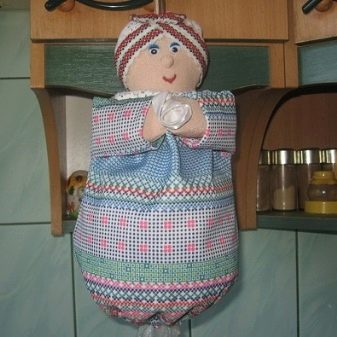

Textile processing: curtains, tablecloths and towels in the kitchen
How and what else can you decorate your kitchen with? Textile decor, of course. But, it is worth remembering: for the kitchen to look stylish, all textiles must be made in the same color scheme or with the same pattern.
In order for the textile decor elements in the kitchen to be matched perfectly, you need to consider the following:
- The kitchen is, first of all, practicality. Therefore, the items used must be of high quality. Cotton, linen are ideal materials for tablecloths, towels and napkins
- Compatibility. When choosing textiles, you need to carefully select the color, pattern, design.But if your kitchen is made in high-tech style, then in this case textiles will be superfluous.
- Tablecloths are what you can use to decorate the kitchen in the dining area. You can use either one or two tablecloths, laid on top of each other. An interesting solution would be to dilute the plain tablecloth with colored napkins.
- Curtains in the kitchen require special attention, since they must not only protect the room from the sun, but also prevent dust and grease from settling on the window. In this case, the material should be with a special impregnation, which will prevent the sedimentation of dirt or its quick elimination.
Stickers in decoration
Kitchen decals are a great way to diversify your interior without a lot of effort and expense. Usually they are used when you need to highlight some part of the kitchen, making a bright accent on it, to mask damage on furniture or a wall, and to update the interior. Most modern decals look like a drawing on the surface, due to the fact that they do not have their own background.
Preference should be given to high-quality vinyl stickers. Regardless of the place of application, after removal, they do not leave marks on the surface (except for paper wallpaper). Stickers are easy to glue by yourself, following the instructions.
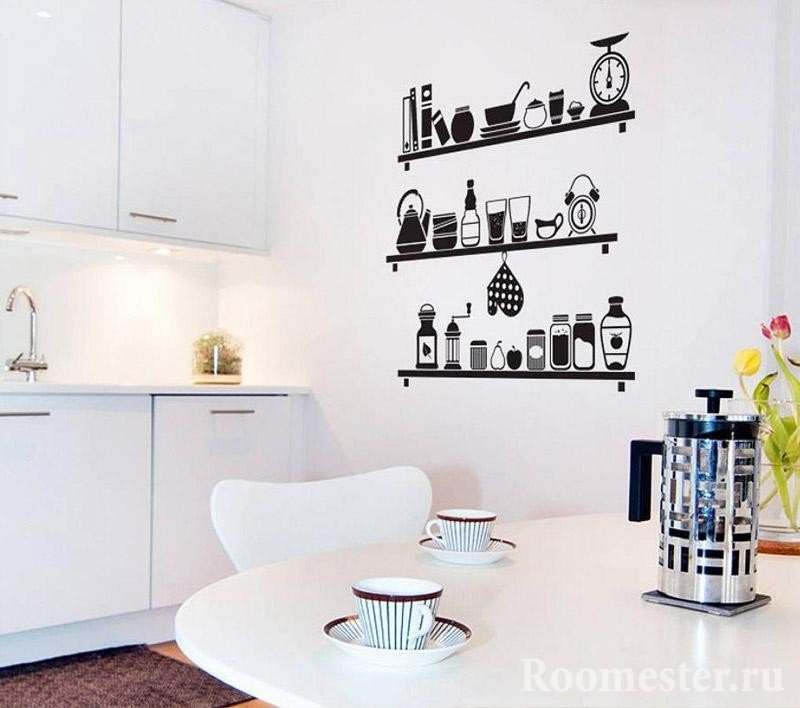
Vinyl kitchen decals usually decorate:
- Painted walls, wallpaper, tiles;
- Window glass;
- Fridge;
- Kitchen cabinets;
- Apron;
- Doors.
If you like the idea with stickers, and you are going to bring it to life, pay attention to a few tips:
- The decal will stick even on embossed surfaces, but looks better on smooth surfaces. Before gluing, the area under the sticker must be washed and degreased.
- When the decal adorns a textured surface, it can be heated with a hairdryer to enhance the texture. If you need to cover the damage with a sticker, the surface must first be leveled. Otherwise, the thin film will accentuate what they tried so hard to hide.
- For the sticker to be removed better, it should be warmed up with a hairdryer.

Kitchen stickers are very diverse: small and large, black and white and colored, single or a whole series of drawings of the same theme.
Wall decoration in the kitchen is a complex, multifaceted job that requires not only artistic literacy from the designer, but also knowledge of the construction business, market opportunities and imagination. If you set a goal, you can create your own, unique interior based on existing projects.
Pattern creation
Making a pattern is the most difficult moment in all work. Only after solving this problem can you start sweeping parts and sewing the product. To prepare a sketch, you will need to take the following measurements:
- half-girth of the thighs;
- length, width of the bib;
- apron parameters;
- the length of the ties on the neck, belt.
After making measurements, you can start creating a sketch. If you do not have enough skills in drawing up a diagram, you can take ready-made models from specialized literature, download from the network, replacing the existing sizes with your own.
According to the existing plan, templates are made for an apron, belt, bib, strings, pocket. For this, you can use thick paper or cardboard. Experienced craftsmen can apply details directly to textiles. It is recommended to use half patterns, since it is much more convenient to cut parts from a double-folded canvas.
Modern style or hi-tech
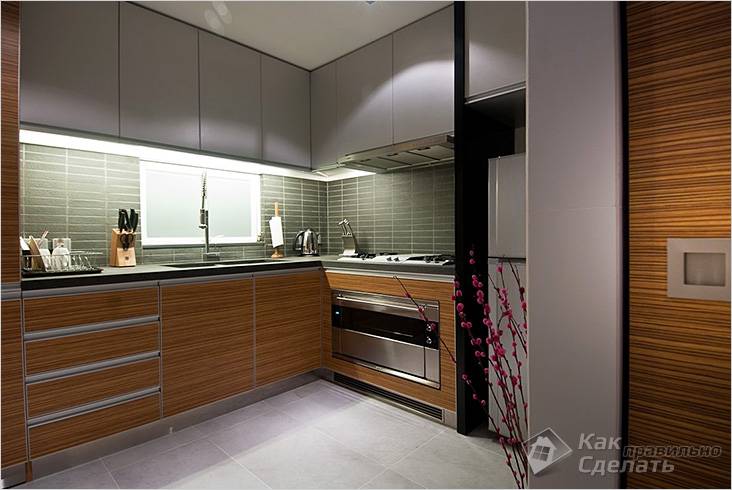 High-tech kitchen
High-tech kitchen
Today hi-tech or modern minimalism is more to the liking of practical people who keep up with the times. The basis of the interior of this style is made by strict functionality, simplicity and brevity. The design is distinguished by straight lines, clear contours, flat planes, glossy and glass surfaces, an abundance of chrome elements, warm light shades.
 Modern downdraft hood
Modern downdraft hood
High-tech is characterized by comfort and functionality, as well as minimal use of decorative elements. This environment will be complemented by the indisputable symbols of the age of technology - innovative devices.
Ceramic tile
The most used material for creating aprons in the kitchen. Refers to natural and environmentally friendly, easy to clean, in case of damage it is easy to replace several tiles. Nowadays, the choice of ceramic tiles is huge, they are available in various shapes from simple square to rectangular in color. Any drawing and ornament is displayed on them. Basic tile models:
- plain tiles of the same shape and color are laid over the entire surface;
- alternate plain tiles of different colors in a checkerboard or random order;
- square and rectangular tiles are arranged, where rectangles with a decorative pattern, or of a different color, are arranged in the form of double-sided borders or corner columns;
- laying tiles with an already applied picture.
If you want to use a tile for decoration, pay attention to its relatively high cost, which consists of the cost of materials and payment for installation work. But once spent, you get a reliable and durable apron model
The original type of tile is a hog - this is a ceramic tile imitating the shape and size of a brick.
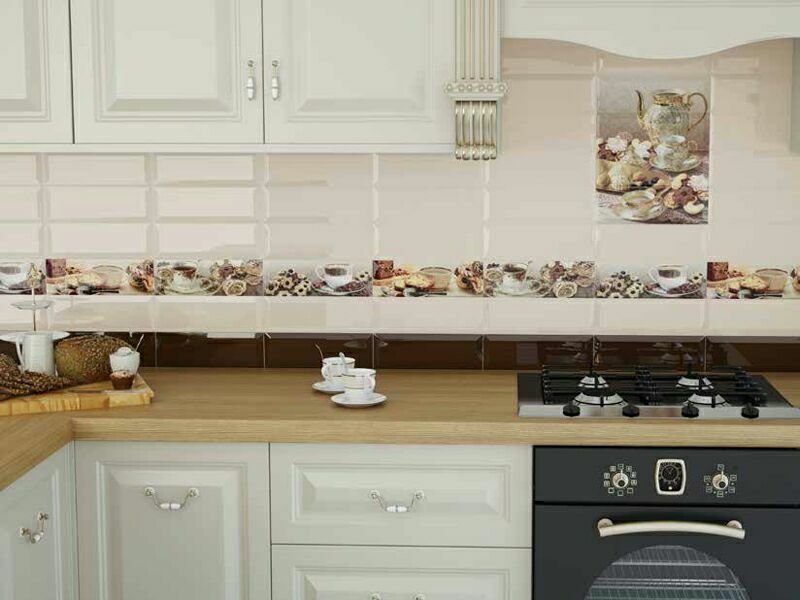
Colors of decoration
The design of a kitchen apron is determined by its color. Choosing it is a difficult task, because using different colors with the same kitchen set can drastically change the overall impression of a room. The colors of the decoration naturally depend on the desired interior and the intended colors of the furniture.
Light shades of the apron, harmoniously fit into the interior of the kitchen of the following styles: romantic, provence, classic. Such colors practically merge with the kitchen set and create the impression of tenderness and sophistication. Perhaps their main drawback is the soiling: every drop of fat is noticeable.
The good thing about the dark shade is that the dirt that got during cooking is not visible, it requires less maintenance, you do not need to wipe it often. In order not to create unnecessary gloom in the interior, designers recommend using glossy reflective materials that add volume. You can enhance the impression with patterns or mosaics in lighter colors. You should not use bright shades of dark colors - purple, burgundy. Kitchen sets are chosen lighter and rarely of the same tone.

Light shades
In a classic interior, light neutral natural shades look great: beige, gray, light brown. They should not contrast with furniture, but should create an impression of integrity and warmth, which is complemented by warm illumination of the work area. Pictures on them are insignificant and dim.
For a romantic interior, pastel colors are chosen: light blue, ash pink, lilac, which are supported by light furniture with interesting decor in the form of curls, flowers, fruits, stained glass. Drawing on them is optional, but it can be large, vague abstractions, flowers.

Dark shades
For high-tech and modern styles, dark aprons are used: black, dark gray, dark blue, play on the contrast of colors with light - white furniture. Sometimes they try to complement the color of the apron with individual interior items: black lamps, chairs, curtains. The materials of the apron are glossy, smooth, the illumination of the working area is of a cold shade.
Sometimes shades of dark tones are used for classic interiors: it is dark brown, dark beige. For kitchens in the style of a loft or eco-style - the texture of the coating repeats the brick or masonry, and the color is red-brick and dark gray, respectively. It is quite rare to stylize aprons to match the texture and color of wood.

Bright colours
If you are wondering about the possibility of using bright colors for a wall apron, let's look at the color options. The best looks create rich fruity shades of pink, fuchsia, red, peach - they add warmth. Bright yellow and orange colors will create a sunny atmosphere even on cloudy days. Green, light green, emerald will calm the nerves. Night blue, turquoise and sky blue add lightness. For a harmonious and holistic visual perception of the kitchen, the colors of the apron are complemented with bright details in the furniture - handles, drawing; on other walls - a picture, wallpaper, accessories - lampshade, curtains. Bright colors on the apron can be present in the form of a large pattern or ornament with a general neutral background: white, milky. Bright colors are typical for modern, minimalism and other contemporary styles.

Idea number 5. We deal with the table and chairs
The use of rattan, soutache cord or burlap thread is an actual option for kitchens in Provence or country styles; paint is more suitable for other designs. You can cover the legs of tables and chairs with threads and cords, which will look very unusual and original. Paint is also a good option for simple kitchen restorations. It is best to use paints in sprays that evenly coat surfaces and dry quickly.
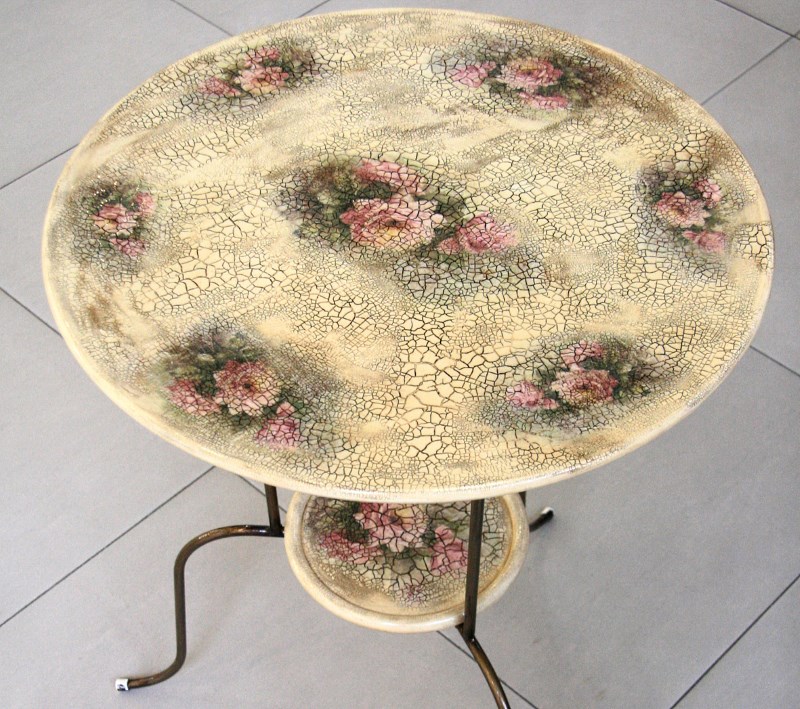
Decoupage of the kitchen table

Chair covers are an easy way to protect furniture from dirt or hide the nondescript look of old finishes.

Tiled mosaic on the kitchen countertop
To decorate the table and chairs, you can not use such radical measures as wrapping with rattan or painting, it is enough to cover them with textiles - a tablecloth and specially sewn capes. Such a design is not relevant in modern, high-tech kitchens. The main thing is not to forget about the color combination: the curtains should be in harmony with the tablecloth and stools on the chairs.
Wall decor in the kitchen
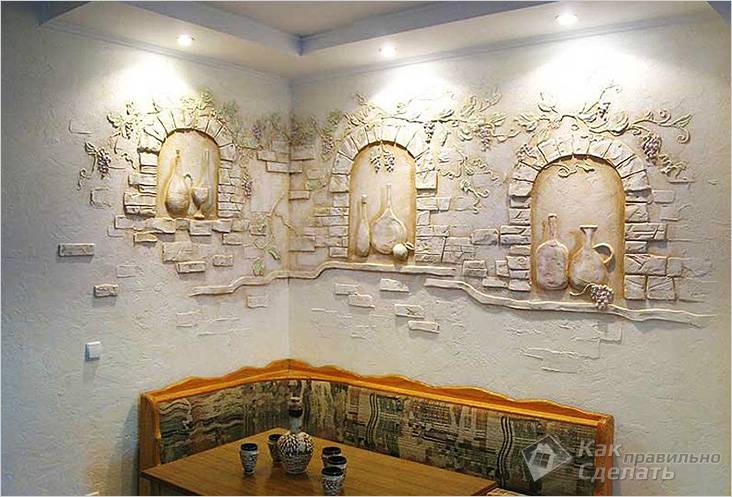
To make a room unique, just hang a picture on the wall. However, there are all sorts of ideas for decorating a wall in the kitchen. Since during the operation of this room contamination is possible, not every finish and not every decor can be used, therefore, the selected finishing materials must be practical.
 Wall decor in the kitchen from tiles
Wall decor in the kitchen from tiles
Sometimes, to add originality to the kitchen, it is enough to add one bright accent. It is better to choose a decor for the wall, taking into account the style of the interior of the entire kitchen. For example, the walls of a kitchen decorated in a modern stylecan be decorated with paintings on glass or colored posters.
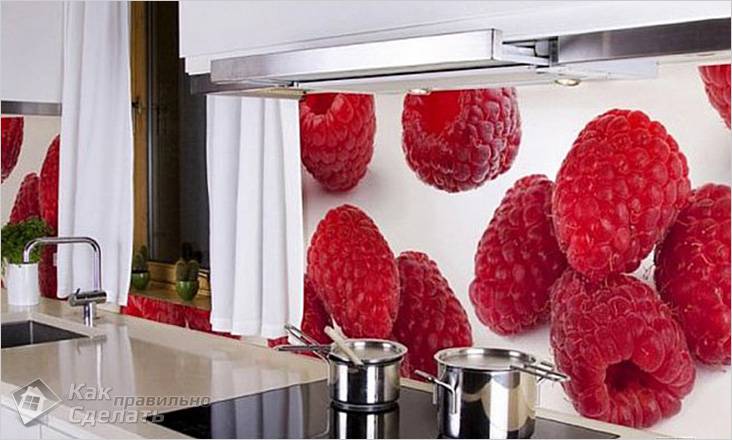 Wall decor with still life
Wall decor with still life
The subject of the paintings in this case can be still lifes depicting gourmet dishes, vegetables, exotic fruits.
Butterflies in the decoration of the wall

Wall decoration with butterflies looks original. They are cut out of Styrofoam, cast out of plaster, painted, stenciled, and eventually standard vinyl decals.
 Multicolored butterflies for wall decoration
Multicolored butterflies for wall decoration
Decor from vinyl decals, stencils and stickers
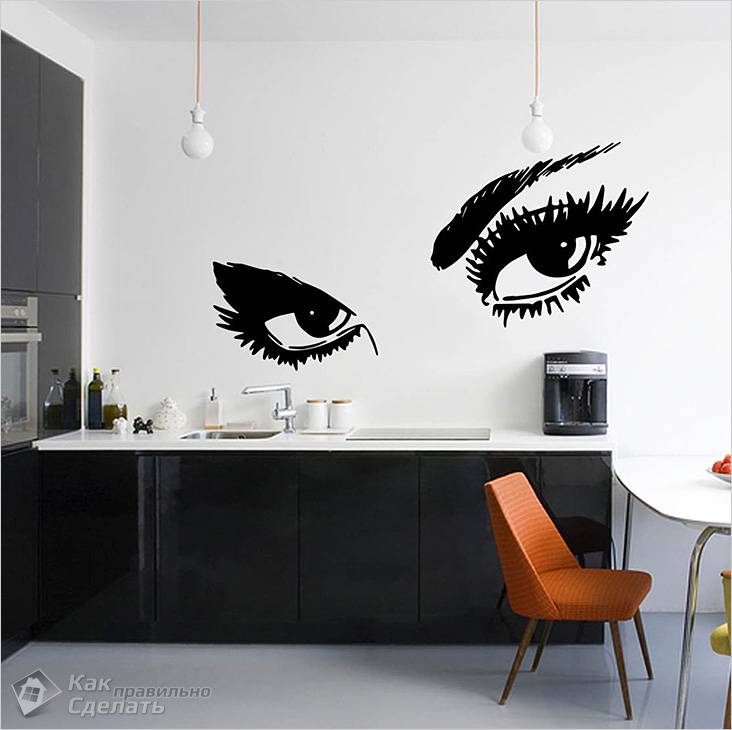 Sticker in the form of female eyes
Sticker in the form of female eyes
An excellent solution for decorating an empty wall will be vinyl stickers with a pattern on a thin self-adhesive film. Such decor is easy to do on your own and, if necessary, replace with another.
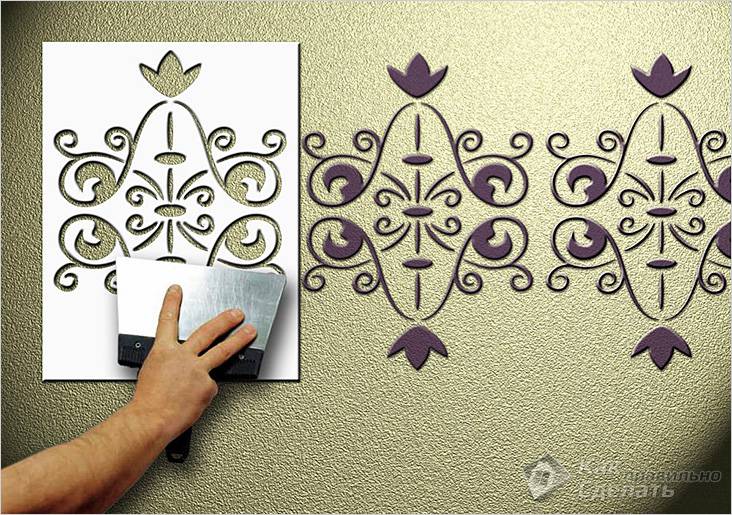 Stencil for wall decor
Stencil for wall decor
Another original way is to use stencils for drawing. With the help of stencils, a small stroke can be used to refine the walls of the kitchen. The classic option is a cup of coffee and a few coffee beans. Stencils can be purchased in specialized stores or made by yourself. In modern design, stickers are very popular... These can be easily distinguishable inscriptions, silhouettes, vignettes. With their help, you can quickly and successfully create the illusion of objects on the wall and, thus, give the wall a finished look.The stickers are durable, easy to maintain and, if necessary, can always be easily removed from the wall.
Furniture decoration
There are many ways to decorate kitchen furniture with your own hands. You can sew covers or bedding on the chairs yourself. It is not difficult to give standard furniture a unique facade.
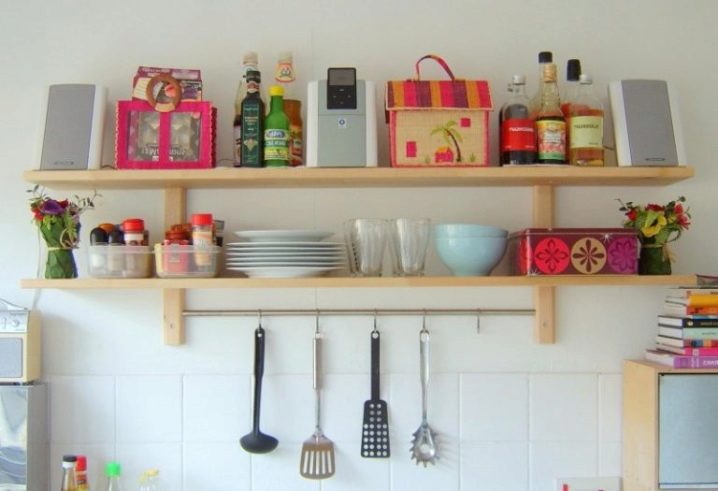
Original ideas will help to realize:
-
all kinds of overlays made of plastic, polyurethane, foam;
-
painting;
-
decoupage;
-
film application;
-
use of original fittings.
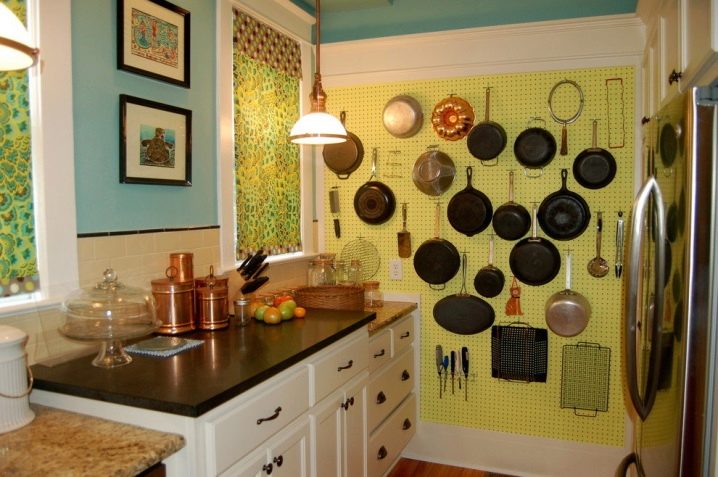
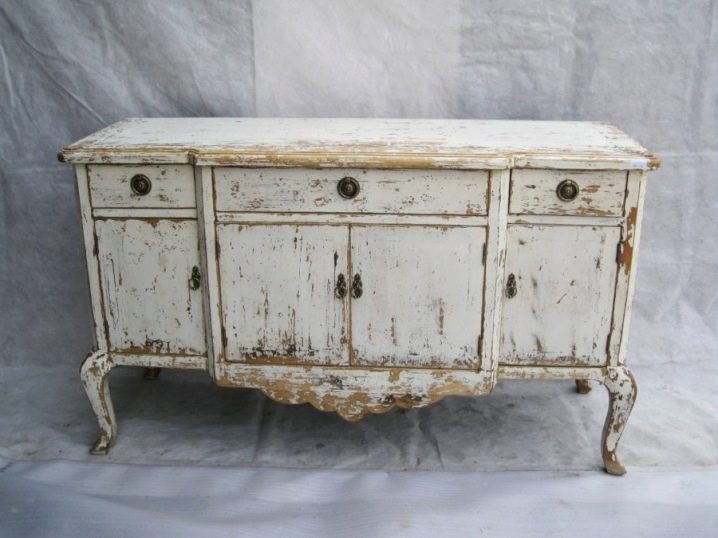
After drying, you need to varnish them, glue suitable pictures. A layer of varnish should be applied on top again. On sale there are ready-made curly borders and onlays that imitate wood carving. During the restoration, you can use them.

Then it is advisable to attach new handles. If a decision is made to leave the old handles, then before painting the furniture, they should be carefully pasted over with masking tape. to protect against falling paint. You can make original handles yourself from cutlery or from miniature metal cups.
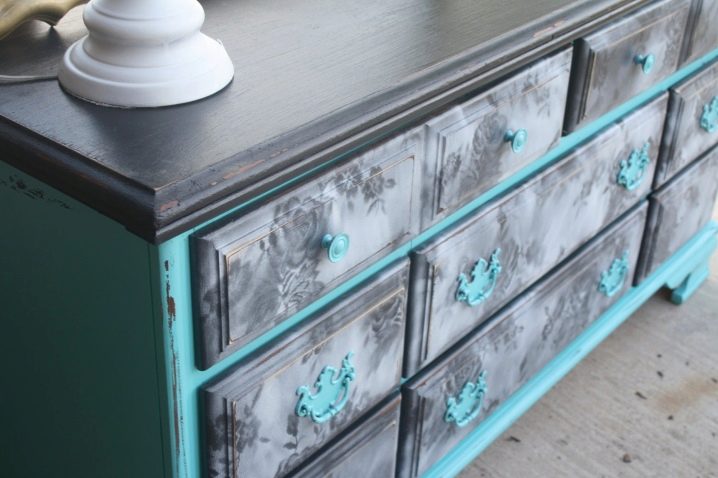
Often, a ready-made print is applied to the furniture. The shops have a large selection of blending napkins. It is customary to place various patterns and contrasting stripes on the doors of the kitchen set. To give the furniture an "aged" look, use craquelure varnishes with a cracking effect. You can choose the appropriate ornament to reproduce ethnic themes.
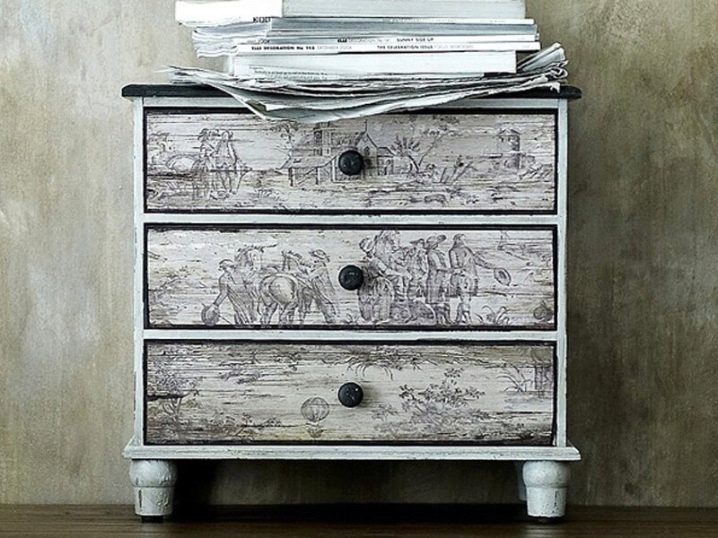
The countertop is usually updated by sticking a film on it. When distributing the film over the table surface, you need to glue the ends well. This is where delamination can begin.
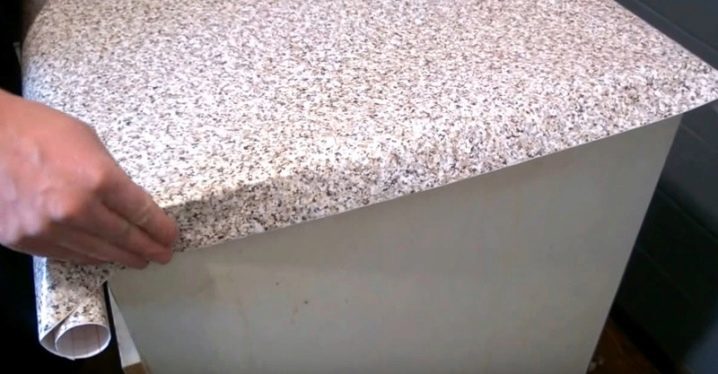
Walls
Replacing the wall decor allows you to radically change the interior of the kitchen space. To decorate the walls requires imagination and some physical effort, but this is the most effective measure to create a completely new look for the kitchen.
Popular ways to decorate kitchen walls:
Stencils

The ornament is applied to plain walls. As a rule, stencils are made with their own hands, which allows you to get a unique web of patterns, giving the kitchen a stylish look.
Wall painting

For those who know how to hold a brush and palette in their hands. Decorating the kitchen with wall painting allows you to create a unique atmosphere in the room.
For those for whom this type of art is not available for any reason, they can update the look of the kitchen by resorting to simple stickers. The views of the seaside or quiet Italian courtyards in wall decals are popular and available online.
Dishes on the walls

Hand-painted decorative plates made of clay and ganch, beautiful dishes included in the wall decor create a positive psychological mood in the kitchen.
Beautifully decorated embroidery, panels and woven fabrics from all over the world look interesting on the walls.
Wooden panels
Kitchen decoration can be done in any style. One popular technique is wood paneling to create a rustic, country or eco-style in the kitchen. The walls are decorated with clapboard or laminate canvases.
A characteristic feature of wood panels is the ability to decorate the premises, taking into account the play of the natural wood color. Dark rocks are used in kitchens located on the south side of the building, where there is a lot of sunlight. In this case, the kitchen is radically transformed, acquiring a unique look.
Light wood is used in the design of a room with insufficient lighting, for example, when the kitchen is located on the north side of the building. Light wood fills the space with warmth and comfort.
Paintings on the walls

Wall panels, paintings, still lifes, compositions collected from photographs dear to the heart will effectively complement the interior of the kitchen. Go well with paintings of botanical illustrations and collection of butterflies.Periodic change of the locations of the decor items leads to a novelty of visual sensations.
Kitchen apron
Without touching the walls, you can radically change the look of your kitchen by working on an apron near the work surface.

There is no need to replace the thermal glass to decorate the kitchen apron. It is enough to use special stickers or stencils.
Choice of fabric
When sewing an apron yourself, a very important point is the choice of the right material for the job. First of all, it is necessary to take into account the fact that the product must protect clothes from pollution, at the same time decorate a person, therefore, the selected textiles must meet certain requirements:
- Convenience. The material should not cause discomfort to the wearer.
- Wear resistance. The fabric used must withstand frequent washings.
- Naturalness. It is better to use natural raw materials that do not have a negative effect on humans.
- Strength. With long-term use, textiles should not lose their structure and quality.
- Attractive appearance.
All fabrics that can be used for self-tailoring of a finished product can be divided into three main types:
- Natural. These include cotton, linen, silk. They are breathable, hypoallergenic, pleasant to the touch, and retain their color for a long time.
- Synthetic. These include lavsan, fleece, acrylic, polysatin. They are very durable, wear-resistant, and have a water-repellent coating. However, they are afraid of high temperatures, do not allow air to pass through, and accumulate static electricity.
- Mixed. This is taslan, tisi, duspo, taffeta. They are distinguished by their low cost, they are easy to clean, do not fade during washing, and have increased wear resistance.

The importance of apron decoration
Thanks to its bright design, the apron becomes a real decorative element of the kitchen that attracts the eye. Choosing the right material keeps your walls and furniture free from dripping grease, steam, water and keeps your kitchen clean. In such conditions, it is pleasant and convenient to cook, create culinary masterpieces with your own hands.
Often the apron becomes the center of the composition, around it all interior items look harmonious. When installing an apron on your own, you should heed the advice of designers and focus on the texture of materials that look unusual and interesting.
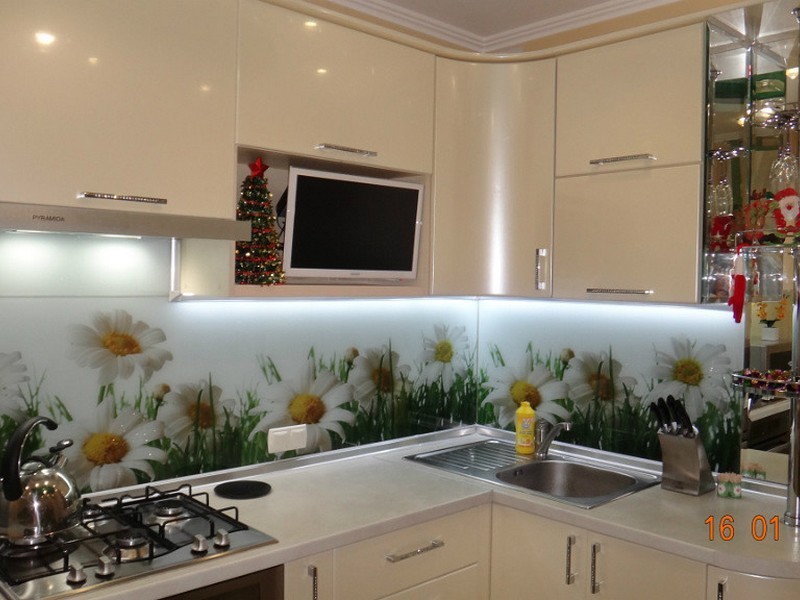
Contemporary styles
Recently, many housewives prefer to use modern kitchen decor, which is due to various design solutions using current technologies. It allows you to apply any color scheme and compared to the previous style, here you can experiment with different shades and colors.

This method allows the use of the most modern materials for wall, floor or ceiling decoration. Stretch ceilings with a reflective effect will visually enlarge the kitchen area.
Bright tiles will brighten your kitchen floor and walls, while artificial lighting systems will help create the atmosphere you need.

Here you can use a variety of decorative elements, including homemade ones. The main thing is that they fit organically into the overall interior. Also, do not forget about the natural landscaping of the room, decorating it with indoor flowers.


In addition, in the role of decorative elements, you can use unnecessary salt appliances, in the form of compositions or wall paintings.

Styles and models for aprons
In a full-fledged family on the kitchen should be at least three aprons for all its members: women, men, children. Each is characterized by a certain type, color. After choosing a fabric suitable for work, you should decide on the model of the future product. To do this, consider the existing styles:
- Aprons. This is the most basic construction, consisting of a piece of fabric and a belt that is tied at the waist. This garment protects only the front of the outer garment.
- One-piece with bib.This model covers the chest, abdomen, hips. Attached to the neck and waist. Made from a single piece of fabric. This is a more practical option compared to the previous one.
- Detachable with bib. It is similar to the previous version, but only partially covers the chest area. These cute pieces accentuate the waist. It includes a belt, lower part, bib.

Decorative plaster
Modern decorative plaster can be perfectly smooth or rough, it allows you to create a surface that imitates fabric, paper, suede, metal, wood, stone, leather. Can be painted in any color. Other original options include decorative art concrete and a coating with a craquelure effect. "Venetian" looks very nice in the kitchen. The business card of the coating is a smooth surface that shimmers in the light with a pearly sheen. Modern mixtures have antiseptic and fungicidal elements in their composition, therefore they prevent the formation of mold in the kitchen.
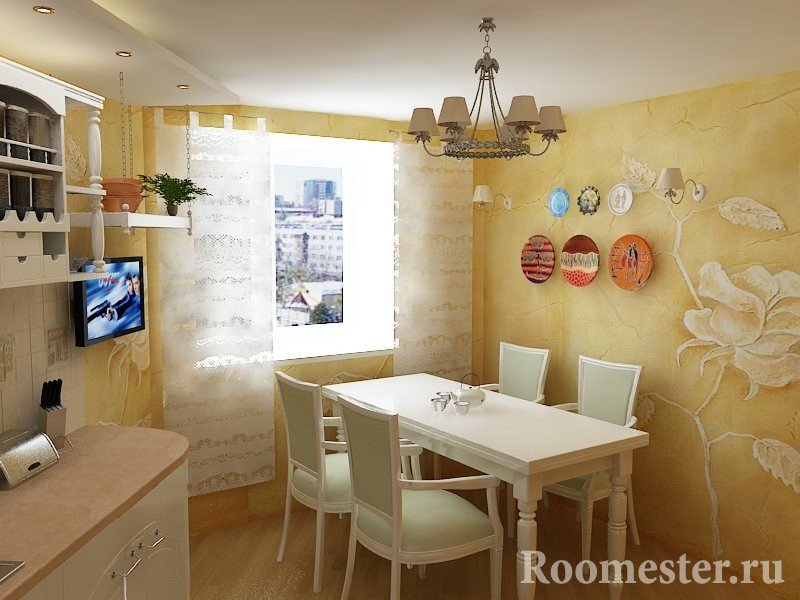
Textured plaster is rarely used on all walls. She usually highlights one wall or dining area. You can decorate the work wall with decorative plaster, and close it with transparent glass from above. In addition, it is customary to supplement the plaster with other decorative elements: artificial stone, decorative brick. The most suitable solution will be in the style of minimalism, loft, shabby chic, country.
It is impossible to say which decorative plaster for the kitchen would be better. It all depends on the interior and personal preferences. Those who are going to make cosmetics should take into account that it is very difficult to remove it. It is literally cut off the wall with a grinder and a perforator. And it is almost impossible to apply it beautifully without experience.


